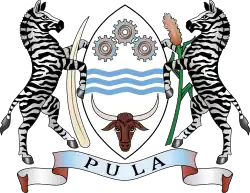The Internet in Botswana is used by approximately 87.2% of the population, as of 2023.[1][2] There has been a massive increase in internet users since 2013 when only 30% of the population of Botswana was found to use the internet.[3][4] This is notably higher than the percentage of internet users in Africa as a whole, which is around 43%.[5] For reference, in 2023, the global statistic for internet users is 66%.
Statistics
| Region | 2005 | 2010 | 2017 | 2019 | 2021 |
|---|---|---|---|---|---|
| Africa | 2% | 10% | 21.8% | 27.7% | 39.7% |
| Americas | 36% | 49% | 65.9% | 75.9% | 83.2% |
| Arab States | 8% | 26% | 43.7% | 55.2% | 70.3% |
| Asia and Pacific | 9% | 23% | 43.9% | 48.9% | 64.3% |
| Commonwealth of Independent States |
10% | 34% | 67.7% | 76.3% | 83.7% |
| Europe | 46% | 67% | 79.6% | 81.7% | 89.5% |
| Subscription | Place | 2007 | 2010 | 2014 | 2019[12] |
|---|---|---|---|---|---|
| Fixed | Africa | 0.1% | 0.2% | 0.4% | 0.4% |
| Americas | 11% | 14% | 17% | 22% | |
| Arab States | 1% | 2% | 3% | 8.1% | |
| Asia and Pacific | 3% | 6% | 8% | 14.4% | |
| Commonwealth of Independent States |
2% | 8% | 14% | 19.8% | |
| Europe | 18% | 24% | 28% | 31.9% | |
| Mobile | Africa | 0.2% | 2% | 19% | 34% |
| Americas | 6% | 23% | 59% | 104.4% | |
| Arab States | 0.8% | 5% | 25% | 67.3% | |
| Asia and Pacific | 3% | 7% | 23% | 89% | |
| Commonwealth of Independent States |
0.2% | 22% | 49% | 85.4% | |
| Europe | 15% | 29% | 64% | 97.4% |
- Internet broadband:
- Internet hosts:
- 1,806 hosts (2012);[7]
- 6,374 hosts (2008).
- Internet IPv4 addresses: 100,096 addresses allocated, less than 0.05% of the world total, 47.7 addresses per 1000 people (2012).[15][16]
- Internet Service Providers:
- 53 ISPs (2020);[17]
- 11 ISPs (2001);
- 2 ISPs (1999).
ADSL
Botswana Telecom rolled out ADSL in early 2006. Current residential ADSL offerings include speeds from 512 kbit/s to 4096 kbit/s with prices from 292 to 863 BWP (~32 to ~97 US$).[18]
ADSL has been introduced in the following areas: Gaborone, Tlokweng, Mogoditshane, Molepolole, Phakalane, Francistown, Lobatse, Palapye, Maun, Kasane, Selibe-Phikwe, Letlhakane, Jwaneng, and Orapa.[19]
Internet censorship and surveillance
There are no government restrictions on access to the Internet or credible reports the government monitors e-mail or Internet chat rooms. The constitution and law provide for freedom of speech and press and the government generally respects these rights. The constitution and law prohibit arbitrary interference with privacy, family, home, correspondence, or browsing pornographic websites, and the government generally respects these prohibitions in practice.[20]
See also
References
 This article incorporates public domain material from The World Factbook (2024 ed.). CIA. 2014. (Archived 2014 edition)
This article incorporates public domain material from The World Factbook (2024 ed.). CIA. 2014. (Archived 2014 edition)
- ↑ "Botswana Population (2023) - Worldometer". www.worldometers.info. Retrieved 2023-12-16.
- ↑ "Internet Users in Africa". www.kaggle.com. Retrieved 2023-12-16.
- ↑ "Botswana - Population 2013 | countryeconomy.com". countryeconomy.com. Retrieved 2023-12-16.
- ↑ "Botswana: number of internet users 2013-2023". Statista. Retrieved 2023-12-16.
- ↑ cycles, This text provides general information Statista assumes no liability for the information given being complete or correct Due to varying update; Text, Statistics Can Display More up-to-Date Data Than Referenced in the. "Topic: Internet usage in Africa". Statista. Retrieved 2023-12-16.
- ↑ "Measuring digital development: Facts and figures 2021". Telecommunication Development Bureau, International Telecommunication Union (ITU). Retrieved 2022-11-16.
- 1 2 3 "Botswana", World Fact Book, U.S. Central Intelligence Agency, 7 January 2014. Retrieved 21 January 2014.
- ↑ "Africa Internet Users, 2018 Population and Facebook Statistics". www.internetworldstats.com. Retrieved 2018-07-16.
- 1 2 Calculated using penetration rate and population data from "Countries and Areas Ranked by Population: 2012" Archived 2017-03-29 at the Wayback Machine, Population data, International Programs, U.S. Census Bureau, retrieved 26 June 2013
- ↑ "Percentage of Individuals using the Internet 2000-2012", International Telecommunications Union (Geneva), June 2013, retrieved 22 June 2013
- ↑ "Measuring digital development: Facts and figures 2019". Telecommunication Development Bureau, International Telecommunication Union (ITU). Retrieved 2020-02-28.
- ↑ Estimate
- ↑ "Fixed (wired)-broadband subscriptions per 100 inhabitants 2012" Archived 2019-07-26 at the Wayback Machine, Dynamic Report, ITU ITC EYE, International Telecommunication Union. Retrieved on 29 June 2013.
- ↑ "Active mobile-broadband subscriptions per 100 inhabitants 2012" Archived 2019-07-26 at the Wayback Machine, Dynamic Report, ITU ITC EYE, International Telecommunication Union. Retrieved on 29 June 2013.
- ↑ Select Formats Archived 2009-05-13 at archive.today, Country IP Blocks. Accessed on 2 April 2012. Note: Site is said to be updated daily.
- ↑ Population, The World Factbook, United States Central Intelligence Agency. Accessed on 2 April 2012. Note: Data are mostly for 1 July 2012.
- ↑ "List of Internet Service Providers" (PDF). Botswana Communications Regulatory Authority. Retrieved 29 May 2020.
- ↑ "Broadband Retail Prices", Botswana Telecommunications Corporation, 1 November 2013. Retrieved 21 January 2014.
- ↑ "Botswana Communications Regulatory Authority | Mmogo re ka kgona bokamoso". www.bocra.org.bw. Retrieved 2020-05-29.
- ↑ "Botswana", Country Reports on Human Rights Practices for 2012, Bureau of Democracy, Human Rights and Labor, U.S. Department of State, 22 March 2013. Retrieved 21 January 2014.
External links
- Botswana Communications Regulatory Authority (BOCRA).
- "Botswana", Africa south of the Sahara: Selected Internet resources, Stanford University Libraries.
- "Computer and Internet Use Among Families: A Case of Botswana", Rama Srivastava and Ishaan Srivastava, BVICAM’S International Journal of Information Technology (New Delhi, 2008).
